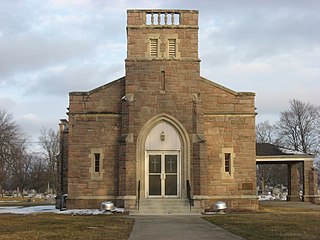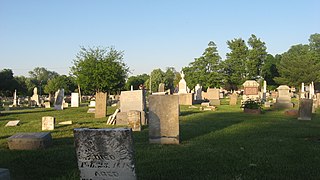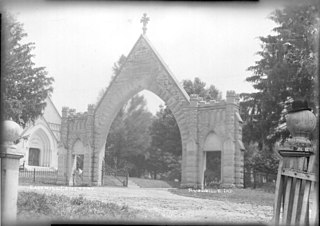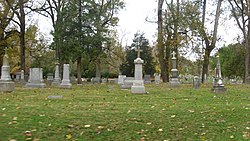
Johnny Appleseed Park, including what was formerly known as Archer Park, is a public park in Fort Wayne, Indiana. It is named after the popular-culture nickname of John Chapman, better known as "Johnny Appleseed", a famous American pioneer, who was buried on the site. Chapman's gravesite is accessible to public view through steel gates. The weathered tombstone says, "Johnny Appleseed He lived for others. 1774–1845." It also has a carved apple in bas relief.

William Steele Holman was a lawyer, judge and politician from Dearborn County, Indiana. He was a member of the Democratic Party who served four different stints as a U.S. Representative from 1859 to 1865, 1867 to 1877, 1881 to 1895, and 1897, spanning sixteen Congresses. He is known for originating the Holman Rule, allowing amendments to appropriations bills to cut a specific program or federal employee salary. He died in office in 1897, a month after his last election.

The Portland Mills Covered Bridge is the second oldest covered bridge in Parke County, Indiana, being built the same year as the Crooks Covered Bridge. It is a single span Burr Arch Truss covered bridge that was built by Henry Wolf in 1856.

The Tippecanoe Twp. District No. 3 Schoolhouse and Cemetery is a place on the National Register of Historic Places in Tippecanoe, Indiana. It was placed on the Register on June 24, 2008. It includes the former schoolhouse of district 3, also known as the Summit Chapel School, that was built around 1860; a cemetery, established in 1844, and a 1930s outhouse built, presumably, by the Works Progress Administration. It is located on Tippecanoe's Summit Hill, the highest point in Marshall County, marking the southernmost point of a glacial advance. From the hill, the Tippecanoe River, one mile south, can be seen with a 270°view from the school. On the eastern edge is a hedge of osage-oranges.

Jesse Lynch Holman was an Indiana attorney, politician and jurist, as well as a novelist, poet, city planner and preacher. He helped to found Indiana University, Franklin College and the Indiana Historical Society. He was one of the first three Justices of the Indiana Supreme Court and a United States district judge of the United States District Court for the District of Indiana.

Beech Grove Cemetery is a large historical cemetery and national historic district located at Muncie, Indiana. It was listed on the National Register of Historic Places in 1999.

Poland Presbyterian Church and Cemetery, also known as Poland Historical Chapel and Poland Cemetery, is a historic Presbyterian church and cemetery on IN 42 near Co. Rd. 56S in Cass Township, Clay County, Indiana. It was built in 1869, and is a gable-front, vernacular frame building with Gothic Revival style design elements. It has a high pitched roof and triangular upper sashes. A vestibule and tower were added in 1893. The adjacent cemetery was founded in 1886, and includes nearly 400 headstones.

Oak Hill Cemetery is a historic cemetery located at Lebanon, Boone County, Indiana. The cemetery was established in 1872 as Rodefer Cemetery, and includes many noteworthy examples of Victorian funerary art. Other notable features are the Late Gothic style William L. Powell Chapel (1930), office building (1955), English barn, the Romanesque Revival style main gate, north gate, the original mausoleum, Metzger Mausoleum, Heath Mausoleum, and Stokes Mausoleum. Notable burials include Indiana governor and U.S. Senator Samuel M. Ralston (1857–1925).

Veraestau is a historic home located in Center Township, Dearborn County, Indiana. It was built in 1838, and is a two-story, Greek Revival style brick and frame dwelling. It incorporates an earlier brick extension to the original 1810 log cabin that burned in 1838. A two-story addition was built in 1913, and a three-room brick addition to it in 1937. Also on the property are the contributing stable and carriage house (1937), Indian mound, family cemetery, and the remains of a kiln. The original house was built by Jesse Lynch Holman (1784-1842). Veraestau was also the birthplace of his son Congressman William S. Holman (1822-1897) and home of his son-in-law Allen Hamilton (1798–1864), who built the 1838 house.

Auburn Community Mausoleum is a historic mausoleum located in Roselawn Cemetery at Auburn, DeKalb County, Indiana. It was built in 1917, and is a one-story, monolithic cubic limestone structure with simple Classical Revival style detail. It features a shallow porch with two Doric order columns. The mausoleum continued to be used for interments into the 1960s.

Garrett Community Mausoleum is a historic mausoleum located in Calvary Cemetery at Garrett, DeKalb County, Indiana. It was built in 1922, and is a one-story, cubic granite structure with simple Classical Revival style detail. It measures 30 feet wide and 42 feet deep. The mausoleum was largely used for interments into the 1950s, with the most recent in 1999.

Butler Community Mausoleum is a historic mausoleum located in Butler Cemetery near Butler in Stafford Township, DeKalb County, Indiana. It was built in 1914, and is a one-story, limestone structure with a red tile roof and simple Classical Revival style detail. It measures 36 feet wide and 78 feet deep and consists of a tall vestibule section and long nave-like wing with clerestory. At the entrance are flanking Doric order columns. The mausoleum was used for interments into the 1960s.

Waterloo Community Mausoleum is a historic mausoleum located in Maplewood Cemetery at Waterloo, DeKalb County, Indiana. It was built in 1916, and is a one-story, rectangular limestone structure with simple Classical Revival style detail and Gothic buttresses. It measures 44 feet wide and 32 feet deep. The mausoleum was used for interments into the 1960s.

Greenlawn Cemetery is a historic cemetery and national historic district located at Franklin, Johnson County, Indiana. It is a landscape-lawn style cemetery established in 1845, and contains roughly 15,000 burials. Located in the cemetery is a small Gothic Revival style chapel and the Romanesque Revival Main Mausoleum (1911).

East Hill Cemetery is a historic cemetery and national historic district located in Rushville Township, Rush County, Indiana. The cemetery was established in 1859 and contains about 14,000 burials. Among the contributing resources are the Gothic Revival entrance arch, a public mausoleum (1935), Payne family mausoleum, Logan family mausoleum, Wilkison crypt, Havens monument, Willkie Memorial designed by sculptor Malvina Hoffman (1885–1966), and the Civil War Monument. The cemetery features numerous examples of high Victorian gravestone art featuring statuary and reliefs. Among the notable burials is Republican presidential candidate Wendell Willkie (1892–1944).

North Meridian Street Historic District is a national historic district located at Indianapolis, Indiana. It encompasses 169 contributing buildings in a high style residential section of Indianapolis. The district developed between about 1900 and 1936, and includes representative examples of Tudor Revival, Colonial Revival, and Classical Revival style architecture. Located in the district is the separately listed William N. Thompson House. Other notable contributing resources include the Evan-Blankenbaker House (1901), Sears-Townsend House (1930), MacGill-Wemmer House, Hugh Love House (1930), Hare-Tarkington House (1911), Shea House (1922), and Brant-Weinhardt House (1932).

Willard and Josephine Hubbard House is a historic home located at Indianapolis, Indiana. It was built in 1903, and is a 2+1⁄2-story, five-bay, center-hall plan, Italian Renaissance Revival style limestone dwelling with an addition. It features a front wooden portico supported by Ionic order columns and a semi-circular front section. Also on the property is a contributing carriage house / garage.

H. Lauter Company Complex, also known as J. Solotken Company, Lauter Lofts, and Harding Street Lofts, is a historic factory complex located at Indianapolis, Indiana. It was built between 1894 and 1912, and includes the South Factory, the North Factory, and the Office Building. The factory buildings are in the Italianate and the office building is in the Classical Revival style. The North Factory is a four-story brick building with a raised full basement constructed sometime between 1908 and 1912. The Office Building is a two-story brick building constructed between 1899 and 1908 and has a truncated hipped roof. The four-story, U-shaped core of the South Factory was built in two phases; the eastern portion between 1894 and 1898 and the western portion in 1899. The H. Lauter Company furniture manufacturer began in 1894 and they continued to operate at the location until 1936. The buildings have been converted to condominiums and apartments.

Indianapolis Public Library Branch No. 6, also known as Spades Park Library (Carnegie), is a historic Carnegie library located in Indianapolis, Indiana. It was built in 1911–1912, and is a two-story, L-shaped, Italian Renaissance style masonry building on a raised basement. It has a terra cotta tile hipped roof, decorative brickwork, limestone accents, and elements of American Craftsman and Arts and Crafts style decorative elements. It was one of five libraries constructed from the $120,000 the Carnegie Foundation gave the City of Indianapolis in 1909 to be used towards the construction of six branch libraries. The library remains in operation as the Spades Park Branch of the Indianapolis Public Library.

Oak Hill Cemetery is a historic rural cemetery located at Evansville, Indiana. It was added to the National Register of Historic Places in 2004.
























